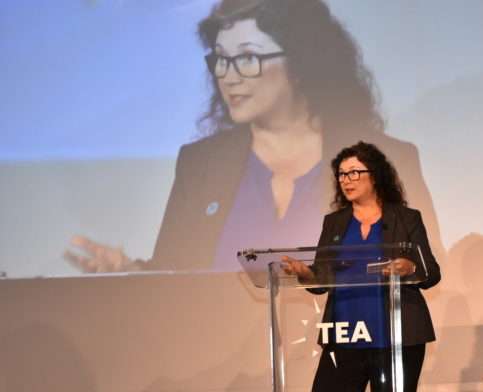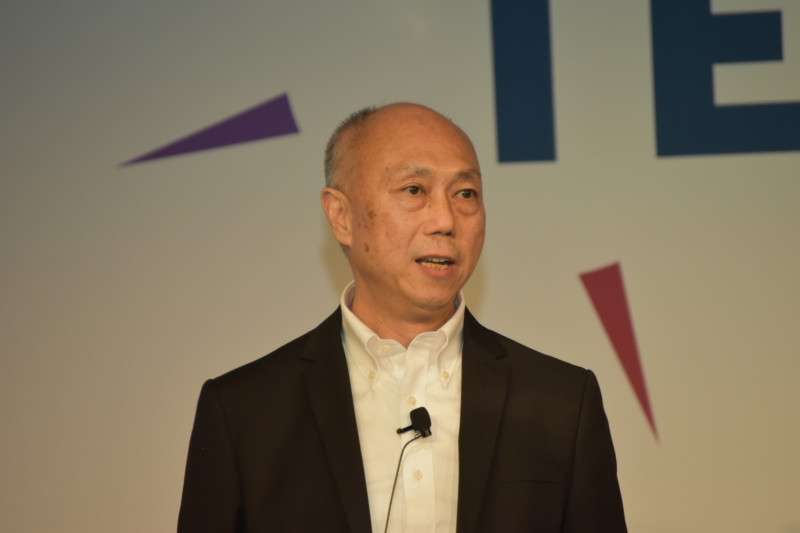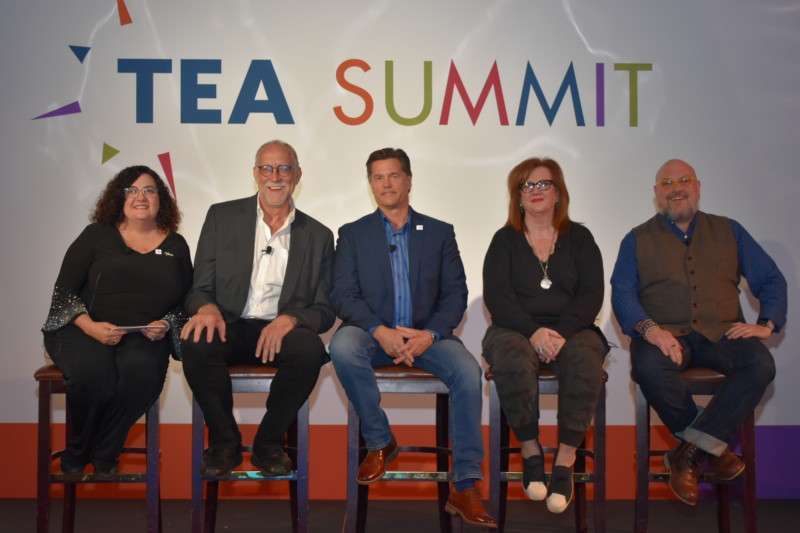Story rides high on the latest tech tools
By Joe Kleiman
读中文
ABOVE: Lisa Passamonte Green, Phil Hettema, Monty Lunde, Susan Bonds and Dave Cobb prepare to lead a panel on submitting Thea Award nominations. All photos courtesy of TEA.
The 2019 recipients of TEA Thea Awards for Outstanding Achievement shared a common trait – the use of technology as a tool to convey a story or evoke emotion.
“Technology is becoming a bigger part of the experiences created for themed entertainment related attractions and events,” said Technifex president Monty Lunde, founder of the TEA.
But… “Technology is not necessarily the driver,” said Lunde, “in that what we ultimately do, as an industry, is convey stories to guests. Advancements in technology give us more tools to affect what guests perceive and how they feel, while they experience our events, spectaculars and attractions. As show related technologies continue to improve, so does our ability to tell even more compelling stories.”
Within that context, there is plenty of variety in how
and what stories are told, and how technology is applied. Based on the
recipients’ presentations at Thea Awards Case Studies Day (part of the annual
TEA Summit preceding the Thea Awards Gala, at Disneyland Hotel in April), we
noted some of these variations.
Be Washington and Nemo & Friends SeaRider
variability leads to repeatability
Technology can enable guests to have a different experience each time they visit an attraction, providing new paths for guest engagement.
George Washington’s Mount Vernon created Be Washington: It’s Your Turn to Lead as an interactive experience that can be experienced three ways – as a scholastic version, which can be facilitated by an educator inside a classroom, an online version, and the physical manifestation of the project – a themed hall at Mount Vernon built in a space once used for distance learning.
The focal point within the Mount Vernon attraction is a 6K screen, 5760 x 1440 pixels. Be Washington confronts the players with four different real-life scenarios that George Washington faced in his presidency. The drama unfolds via high definition media produced by Cortina Productions. Historic figures give advice and new information. At the conclusion, participants’ decisions are compared to those George Washington made. The combination of multiple live participants playing together and the choice of scenarios means that no two experiences are the same.

On the other side of the globe, Tokyo DisneySea has repurposed its StormRider motion simulator ride as the new Nemo & Friends SeaRider, based on the Disney-Pixar animated film “Finding Nemo” and its sequel. It (virtually) shrinks park guests within a fish-shaped vehicle, from which they observe (digitally animated) sea life up close.
Variability is provided in multiple ways. The ride is broken up into chapters, each with a number of possible scenarios that can work in combination, each having the exact same number of frames. According to Roger Gould of Pixar, creating the film was a special challenge as each chapter had to tie in seamlessly with the ones bookending it, without the advantage of cuts or effectsbased transitions. Since the front of the SeaRider vehicle has a proscenium window in front of the curved screen, those guests riding in the front are able to see additional imagery to the left and right, while those further back can enjoy synched animation on a series of new monitors that run the length of the cabin.
Basyliszek, JUSTICE LEAGUE™: Battle for Metropolis and Fantawild Oriental Heritage
new tricks for dark rides
Accessible technology and highly creative external teams bring high-end storytelling experiences to smaller parks.
With a population of 40 million in its market, Polish park Legendia sought a breakthrough indoor attraction to mark its 60th anniversary and help transition the property to year-round operation. The park partnered with Alterface and Jora Vision to create Bazyliszek, an interactive media-based dark ride themed around a mythical Polish creature. Existing characters from throughout the park were also given a new boost, integrated into the attraction as sidekicks. Without using stereoscopic 3D, tricks of the trade were used to create a sense of depth, such as a perspective shift on screen and the use of black light with projection mapping.

JUSTICE LEAGUE™: Battle For Metropolis at Six Flags Magic Mountain marks the attraction’s seventh installation at a Six Flags park. Six Flags enlisted an external creative team led by Sally Corporation to develop and customize each installation. According to Rich Hill of Sally, a key differentiator is that physical sets are built in a 360-degree environment. The ride is also designed to evoke some of the thrills of Six Flags coasters, such as a simulated corkscrew twist in a subway and a 360-degree loop created by Green Lantern’s ring.
At the heart of Fanatawild Oriental Heritage park in Xiamen, China are several high tech media-based attractions telling great stories of Chinese folklore. According to Fantawild’s Daisy Shang, “We wanted to develop a high-tech theme park highlighting Chinese culture. In choosing our stories, we looked at two things. Do the stories connect with a modern audience? Can the story be displayed with modern technology?” In addition to two multi-screen dark rides, the park features a fulldome theater where the floor rises and rotates, as well as a large auditorium featuring a four-sided AR presentation in the center.
Fantastic Journey and Intel Shooting Star
drones in the show
Drones are being integrated into live performances, creating new types of lighting and show platforms.
Princess Cruises’ newest ship, the Majestic Princess, is the first new international luxury cruise liner tailor-made to cater to the Chinese market. Using China’s rich heritage of epic visual storytelling as inspiration, a key storytelling device of its signature show, Fantastic Journey, is a series of rotating doors. According to Danny Teeson, the show’s director, “One side of the door is made up of LED panels, the other is a white surface that we projection map on. We share the stage with two other shows, both of which have large, three-dimensional sets, so it was important that we minimize our sets, but still pack a punch.”
The show also utilizes 32 drones, 14 in each performance, that dance in the air around a live performer – the goal being to abolish the divide between stage and audience. Because the drones are mapped into fixed locations inside the theater, located inside the center of one of the world’s largest cruise ships, the show’s production crew has begun utilizing their position relative to the stage to determine the wave conditions outside the ship.
Intel Shooting Star Drones have been featured worldwide from the Super Bowl to the Olympics. At Travis Air Force Base near Sacramento, California, the drones served as an alternative for a traditional fireworks show (see http://www.inparkmagazine. com/travis-afb-intel-drones/). Within the theme park community, the Shooting Stars have been seen in “Starbright Holidays” at Disney Springs, Walt Disney World Resort, and most recently during “Dark Arts at Hogwarts” at Universal Studios Hollywood.
Each Shooting Star drone features a four chip LED capable of up to four million color combinations. There is also a smaller indoor version, the Shooting Star Mini, weighing in at 40 grams. Safety is, of course, a design priority and there are numerous built-in safeguards. Ani Nanduri, vice president and GM of the Intel Drone Group, told InPark that the biggest obstacles they encounter with flying the drones tend to be radio interference and the aerospace regulations. “The drones are aircraft,” he said, “and regulations differ from country to country. Sometimes we have to film the flight beforehand, like at the PyeongChang Winter Olympics. We would not have been able to fly the drones live over the ceremony because we would have been flying over people and that would have been a violation of the local flight restrictions.”
LEGO® House and Slidewheel
new types of structures
A real-life building designed with LEGO® bricks and a rotating waterslide based on the structure of DNA highlight unique approaches to architecture.
LEGO® House is the official brand center of LEGO Group. Located in Billund, Denmark, which is also home to the original LEGOLAND® Park, operated by Merlin Entertainments, LEGO® House promotes cognitive development through interactivity, or “Learning through Play.” The building’s architecture was developed with a scale model comprised of 21 LEGO® bricks stacked in an offset formation. Within the building are four zones, each offering a different approach to play. There are also 13 outdoor play areas. Being oriented to lifetime learning, the activities appeal to adults as well as children and the attraction has developed a successful side business catering to meetings and conferences, especially those involving team building.

As the SlideWheel story goes, in 2012, a boy in Switzerland sat on his father’s lap watching a documentary about DNA. He began to envision a waterslide shaped like the helix structure of a DNA strand attached to a rotating wheel and patented the idea in 2013. The patent was licensed by waterpark supplier wiegand.maelzer and marketed as the SlideWheel. Chimelong Group purchased the first production model for its Chimelong Water Park in Guangzhou, China. As the 24-meter tall wheel rotates, rafts move back and forth between chambers, with up to three rafts inside the SlideWheel at any given moment. The SlideWheel was given the iconic place of honor at the center of the waterpark, and plays a double role as a visual spectacle, with a kinetic nighttime persona thanks to a package of more than 700 LED lights.
Chimelong was the first to adopt the SlideWheel, but we can expect to see more in coming years; WhiteWater West has partnered with Wiegand Maelzer to become a licensed SlideWheel supplier.
The Evel Knievel Museum and Legend of Camel Bells
bringing history to life
Whether low- or high-budget, new experiences take visitors on extraordinary journeys through history.
The Evel Knievel Museum is an extension of a Harley Davidson dealership run by the Patterson family in Topeka, Kansas. With a reputation for restoring vintage motorcycles, the dealership took on its biggest project to date – the restoration of Big Red, renowned stuntman Evel Knievel’s big rig truck. With access to Lathan McKay’s collection of Knievel memorabilia, one of the world’s largest, the dealership built a 16,000 square foot, two story museum. Dimensional Innovations developed interactives for the museum, which include a “Bad to the Bones” exhibit, where visitors can examine all the ways Knievel broke his bones, including 40 X-ray images, and a Jump Planner (both activities meet STEM requirements). The interactive highlight of the museum is a VR motorcycle jump using media filmed in downtown Topeka with a stunt rider. Visitors mount a motorcycle and don VR gear as they prepare to recreate one of Knievel’s jumps.
Re-creation is at the heart of Legend of Camel Bells, at Huaxia Cultural Tourism Resort in Xi’an, China. Housed under a giant dome, the centerpiece of the show is the 3,000-seat grandstand, which rotates and travels the length of the dome, bringing the audience to each of the six large set pieces that tell the story of the Silk Road during the Tong dynasty. Throughout the journey, visitors experience a 4,000 square meter LED screen, a 2,000-ton waterfall, camels, wolves, and a cast of thousands. As the grandstand rotates within the structure, sound emanates from speakers embedded both in the grandstand and in each of the sets. Additionally, two center channels hang from each end of the ceiling, with one set of speakers always above the grandstand. The end result is that no matter where the grandstand is in the dome, the audience always experiences 5.1 surround sound. [See “Legends, Camels and ACE,” InPark issue #76]
ILLUMINATIONS: human/nature and Volcano Bay
honoring indigenous cultures
Through unique applications of technology, projects honor indigenous peoples.
As part of Canada’s 150th anniversary, Banff Center for Arts and Creativity, in conjunction with Canadian artist Sarah Fuller and Montreal-based Moment Factory, developed ILLUMINATIONS: human/nature. The event took place on historic indigenous land in Canada’s oldest national park, Banff, in Alberta, and its newest, Rouge National Urban Park, near Toronto, Ontario. Researchers for the project interviewed First Nation tribe members, leading to storylines based upon ancient tales. During the limited run of this experience, participants in small groups carried lanterns, projectors, and other tools into the wilderness, looking for clues as they pieced together a story telling the relationship between humans and nature. The experience ended at a campfire where multimedia images came to life.

Universal’s Volcano Bay is not themed to any single indigenous people, but pays homage to the various Polynesian groups found throughout the South Pacific. The park is designed around a series of backstories. The first is the legend of Krakatau, named for the Indonesian volcano. In Volcano Bay lore, Krakatau is a god who banishes his daughter to the heavens, where she becomes the moon. In grief, he created a volcano and trapped his anger, which he called Vol, inside. This volcano lies at the center of Volcano Bay. For its other backstory, Universal Creative developed the story of the Waturi people, who traveled the world meeting with many cultures, searching for a sacred fish called the Kunuku. They eventually settled into a new home at Volcano Bay. Because of the Waturi’s travels throughout the Pacific, buildings throughout the park are designed with authentic architectural elements from throughout the Pacific Rim. (See also “An eruption of accolades: Universal’s Volcano Bay honored with a TEA Thea Award,” InPark issue #77)
MORI Building DIGITAL ART MUSEUM and Universal Spectacle Night Parade
storytelling beyond projection mapping
For two Japanese projects, projection mapping is only the beginning.
Takashi Kudo, Communications Director of teamLab, described the MORI Building DIGITAL ART MUSEUM near Tokyo this way: “I don’t know how to describe it.” While projection mapping has become commonplace around the world, and fullroom digital art instillations have been awarded Thea Awards in the past (such as Les Carrières de Lumières), MORI Building DIGITAL ART MUSEUM is something more. Housed within a 100,000 square foot space, with five unique zones, animations can be interacted with, move freely from space to space, interact with other animations, and even fuse together. The arbitrary nature of the animations sometimes results in unforeseen circumstances. In the Flower Room, flowers bloom and die as people move through the space. According to Kudo, “We had so many people when we opened, they killed all the flowers. People were walking around the room wondering why nothing was there.”

At Universal Studios Japan in Osaka, the Universal Spectacle Night Parade utilizes 54 projectors on a variety of building surfaces, with different projections for each unit of the parade, creating a three dimensional atmosphere that extends beyond the floats. The projection mapping, however, is a tool to help create ambiance and tell the parade’s story. Separated into four units, each themed to a different film franchise – Harry Potter, Minions, Jurassic Park, and Transformers – the parade features 15 floats, 100 performers, and 107 support staff per show. Like many of the projects showcased this year, the parade has an element of variability, as no two locations on the parade route offer the same experience, a catalyst for return visitation. According to Mike Davis, Senior Vice President-International Entertainment at Universal Parks and Resorts, “I’m very proud of the fact that we used theatrical lighting for this parade. It makes a huge difference. I especially love the moonlight effect in the Harry Potter scene.” • • •
Thea by the numbers
This year saw new trends in storytelling and demographics among the 15 recipients of TEA Thea Awards for Outstanding Achievement.
• Four used IP based on motion pictures or brands
• Two were based on actual historic individuals and events
• Three were based on local and indigenous myths and tales
• Three utilized original IP for creating the storyline and experience
• Seven cater to the Asian audience – three in Japan and four in China
• Of the projects located in Asia, four were designed exclusively by local teams in those nations






